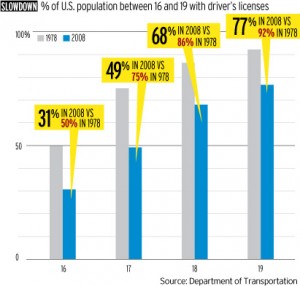 Over the past few years we’ve witnessed the compilation of the perfect storm: The economy is still hurting; everyone is going green; smartphone and mobile technology is growing by the minute; and the youngest generations no longer associate a sense of freedom with the reaction time of their cars, like their parents did, but instead they see freedom in the reaction time of their mobile screens.
Over the past few years we’ve witnessed the compilation of the perfect storm: The economy is still hurting; everyone is going green; smartphone and mobile technology is growing by the minute; and the youngest generations no longer associate a sense of freedom with the reaction time of their cars, like their parents did, but instead they see freedom in the reaction time of their mobile screens.
What does it mean?
It means there’s been a paradigm shift. We’ve changed, our expected norms have changed, and the U.S. car culture has changed. Fewer and fewer younger people are driving, says a new Ad Age article that is based on data from the Department of Transportation, and they don’t really want to. While 92% of 19 year olds had a driver’s license in 1978, the number decreased to 77% in 2008.
Why such a significant drop?
Maybe it’s a result of higher gas prices and thinner wallets; or how it’s suddenly cool to carpool because you’re saving the planet.
But perhaps it also has to do with the emergence of mobile technology, and the desire to be connected CONSTANTLY. You can’t text or play on your phone when you’re driving (at least we’re not condoning it!), and you certainly can’t use your laptop. Yet our time becomes more valuable as the need to be productive and be on our mobile devices continues to increase. So what’s the simple solution? People are turning to public transportation.
While the car industry might not like it, the younger generation sees an opportunity to save the environment while getting more done. The next generation will have careers more geared toward creating intangibles in a service economy, as opposed to the production economy of U.S. past. This means that work gets done via laptop and Blackberry on the train or bus, rather than wasting perhaps upwards of a few hours a day in unaccomplished commute. Driving is a lot less appealing than it used to be for the notoriously unproductive and freedom-craving younger generations.
What does this mean for marketers?
It’s reassurance that mobile is the road to these Gen Ys and Millennials. And perhaps brick and mortar has become the detour.
Like your favorite movie that skipped over the big screen, these “Internet-first” shoppers go right to the Web site because it’s the easiest, fastest, cheapest way. Is driving really out for good? We doubt it. But there’s no denying that the consumers of the future will spend a significant amount of time interacting in the infinite land of the world wide web. And with more mobility and less down time from the pesky distraction of driving themselves, there’s plenty of time for consumers to find your company where ever they go.











